Indoor Air Quality Management in Dubai: Assessing the Efficacy of Air Purifiers, Photocatalysts, and Window Ventilation in Reducing HCHO
Abstract
:1. Introduction
2. Materials and Methods
2.1. IAQ Standards
2.2. Research Methods
2.2.1. Measurement Overview
2.2.2. Concentration of Formaldehyde (HCHO)
2.2.3. Indoor/Outdoor Temperature and Humidity
2.2.4. CO2 Concentration for Measuring Ventilation
3. Results
3.1. HCHO Concentration in Each Room with the Windows Closed
3.2. Effect of Reducing HCHO Concentration by Air Purifier
3.3. Effect of Reducing HCHO Concentration by Photocatalyst Construction
3.4. HCHO Concentration According to Window Opening Conditions
3.5. Relationship between HCHO Concentration and Temperature and Humidity
4. Discussion
5. Conclusions
- Health Risks from Sealed Rooms: When windows were sealed, HCHO concentrations in all rooms exceeded the domestic environmental standard of 0.1 ppm, posing potential health risks, particularly in the Master Bedroom (MBR), where levels reached 0.73 ppm. This underscores the need for effective measures to reduce HCHO levels to safeguard occupant health.
- Effectiveness of Air Purifiers: The air purifier equipped with a VOCs-only filter demonstrated limited immediate impact on HCHO levels, with a significant reduction observed only after 24 h of continuous operation. This suggests that while air purifiers can contribute to lowering HCHO concentrations, their efficacy is gradual and may require extended use.
- Impact of Photocatalysts: The application of a photocatalyst on various surfaces within the MBR and Room 2 resulted in a substantial 50% reduction in HCHO concentrations, regardless of lighting conditions. This highlights the potential of photocatalysts as an effective strategy for mitigating HCHO emissions from indoor finishes.
- Role of Ventilation: Ventilation rates were found to be critically low with sealed windows but increased dramatically when windows were opened, with the air change rate (ACH) reaching as high as 9.55 per hour. This finding emphasizes the importance of proper ventilation in maintaining indoor air quality.
- Window-to-Room Ratio Considerations: Despite increased ventilation, HCHO concentrations in the living room and MBR remained above the WHO standard of 0.1 ppm. However, in smaller rooms like Room 1 and Room 2, with a larger window-to-volume ratio, HCHO levels were maintained at or below the WHO standard with minimal window openings, highlighting the significance of room size and window area in ventilation effectiveness.
- Comparative Effectiveness of Mitigation Strategies: Among the strategies tested, ventilation by opening windows proved to be the most effective in reducing HCHO concentrations across all rooms. This finding advocates for implementing robust ventilation practices in newly constructed residential buildings to ensure healthy indoor environments.
Author Contributions
Funding
Data Availability Statement
Acknowledgments
Conflicts of Interest
Abbreviations
| IAQ | Indoor Air Quality |
| HCHO | Formaldehyde |
| VOC | Volatile Organic Compounds |
| MBR | Master Bedroom |
| ACH | Air Change per Hour |
| MDF | Medium-Density Fiberboard |
| TiO2 | Titanium Dioxide |
| UV | Ultraviolet |
| CO2 | Carbon Dioxide |
| SBS | Sick Building Syndrome |
| ppm | Parts Per Million |
| WHO | World Health Organization |
| ASHRAE | American Society of Heating, Refrigerating, and Air-Conditioning Engineers |
| JBSA | Japan Building Standard Act |
| MOE | Ministry of the Environment (South Korea) |
| NAAQS | National Ambient Air Quality Standards (USA) |
| FISIAQ | Finnish Society of Indoor Air Quality and Climate |
| EPA | Environmental Protection Agency (USA) |
References
- Arar, M.; Jung, C. Analyzing the perception of indoor air quality (IAQ) from a survey of new townhouse residents in Dubai. Sustainability 2022, 14, 15042. [Google Scholar] [CrossRef]
- Awad, J.; Jung, C. Evaluating the indoor air quality after renovation at the Greens in Dubai, United Arab Emirates. Buildings 2021, 11, 353. [Google Scholar] [CrossRef]
- Jung, C.; Awad, J. The improvement of indoor air quality in residential buildings in Dubai, UAE. Buildings 2021, 11, 250. [Google Scholar] [CrossRef]
- Nair, G.; Verde, L.; Olofsson, T. A review on technical challenges and possibilities on energy efficient retrofit measures in heritage buildings. Energies 2022, 15, 7472. [Google Scholar] [CrossRef]
- Collins, M.; Dempsey, S. Residential energy efficiency retrofits: Potential unintended consequences. J. Environ. Plan. Manag. 2019, 62, 2010–2025. [Google Scholar] [CrossRef]
- Martins, N.R.; da Graça, G.C. Simulation of the effect of fine particle pollution on the potential for natural ventilation of non-domestic buildings in European cities. Build. Environ. 2017, 115, 236–250. [Google Scholar] [CrossRef]
- Pei, J.; Yin, Y.; Liu, J. Long-term indoor gas pollutant monitor of new dormitories with natural ventilation. Energy Build. 2016, 129, 514–523. [Google Scholar] [CrossRef]
- Jung, C.; Mahmoud, N.S.A.; Alqassimi, N. Identifying the relationship between VOCs emission and temperature/humidity changes in new apartments in the hot desert climate. Front. Built Environ. 2022, 8, 1018395. [Google Scholar] [CrossRef]
- Jung, C.; Al Qassimi, N.; Arar, M.; Awad, J. The analysis of indoor air pollutants from finishing material of new apartments at business Bay, Dubai. Front. Built Environ. 2021, 7, 765689. [Google Scholar] [CrossRef]
- Salimi, M.; Al-Ghamdi, S.G. Climate change impacts on critical urban infrastructure and urban resiliency strategies for the Middle East. Sustain. Cities Soc. 2020, 54, 101948. [Google Scholar] [CrossRef]
- Nevalainen, A.; Täubel, M.; Hyvärinen, A. Indoor fungi: Companions and contaminants. Indoor Air 2015, 25, 125–156. [Google Scholar] [CrossRef] [PubMed]
- Jung, C.; Mahmoud, N.S.A. Extracting the critical points of formaldehyde (HCHO) emission model in hot desert climate. Air Soil Water Res. 2022, 15, 11786221221105082. [Google Scholar] [CrossRef]
- Jung, C.; Abdelaziz Mahmoud, N.S. Navigating dust storms and urban living: An analysis of particulate matter infiltration in Dubai’s residences. Front. Built Environ. 2023, 9, 1297520. [Google Scholar] [CrossRef]
- Leung, D.Y. Outdoor-indoor air pollution in urban environment: Challenges and opportunity. Front. Environ. Sci. 2015, 2, 69. [Google Scholar] [CrossRef]
- Sherzad, M.; Jung, C. Evaluating the emission of VOCs and HCHO from furniture based on the surface finish methods and retention periods. Front. Built Environ. 2022, 8, 1062255. [Google Scholar] [CrossRef]
- Niza, I.L.; de Souza, M.P.; da Luz, I.M.; Broday, E.E. Sick building syndrome and its impacts on health, well-being and productivity: A systematic literature review. Indoor Built Environ. 2024, 33, 218–236. [Google Scholar] [CrossRef]
- Abdelaziz Mahmoud, N.S.; Jung, C. Analyzing the bake-out effect in winter for the enhancement of indoor air quality at new apartments in UAE. Buildings 2023, 13, 846. [Google Scholar] [CrossRef]
- Amoatey, P.; Omidvarborna, H.; Baawain, M.S.; Al-Mamun, A. Indoor air pollution and exposure assessment of the gulf cooperation council countries: A critical review. Environ. Int. 2018, 121, 491–506. [Google Scholar] [CrossRef]
- Jung, C.; El Samanoudy, G. Mitigating indoor air pollution in university dormitory: The need for better ventilation and resident awareness. Buildings 2023, 13, 1144. [Google Scholar] [CrossRef]
- Sadrizadeh, S.; Yao, R.; Yuan, F.; Awbi, H.; Bahnfleth, W.; Bi, Y.; Cao, G.; Croitoru, C.; de Dear, R.; Haghighat, F.; et al. Indoor air quality and health in schools: A critical review for developing the roadmap for the future school environment. J. Build. Eng. 2022, 57, 104908. [Google Scholar] [CrossRef]
- Campagnolo, D.; Saraga, D.E.; Cattaneo, A.; Spinazzè, A.; Mandin, C.; Mabilia, R.; Perreca, E.; Sakellaris, I.; Canha, N.; Mihucz, V.G.; et al. VOCs and aldehydes source identification in European office buildings-The OFFICAIR study. Build. Environ. 2017, 115, 18–24. [Google Scholar] [CrossRef]
- Zhu, Y.; Guo, S.; Liang, W. A literature review investigating the impact of temperature and humidity on volatile organic compound emissions from building materials. Build. Environ. 2024, 262, 111845. [Google Scholar] [CrossRef]
- Wang, H.; Xiong, J.; Wei, W. Measurement methods and impact factors for the key parameters of VOC/SVOC emissions from materials in indoor and vehicular environments: A review. Environ. Int. 2022, 168, 107451. [Google Scholar] [CrossRef]
- Jung, C.; Abdelaziz Mahmoud, N.S.; Al Qassimi, N.; Elsamanoudy, G. Preliminary study on the emission dynamics of TVOC and formaldehyde in homes with eco-friendly materials: Beyond green building. Buildings 2023, 13, 2847. [Google Scholar] [CrossRef]
- Arar, M.; Jung, C.; Qassimi, N.A. Investigating the influence of the building material on the indoor air quality in apartment in Dubai. Front. Built Environ. 2022, 7, 804216. [Google Scholar] [CrossRef]
- Jung, C.; Ismail, M.A.; Arar, M.; AlQassimi, N. Mitigating indoor air pollution in UAE’s high-rise apartment buildings: A study on eco-friendly materials and adsorbents. Smart Sustain. Built Environ. 2024. [Google Scholar] [CrossRef]
- Lim, J.; Kim, S.; Kim, A.; Lee, W.; Han, J.; Cha, J.S. Behavior of VOCs and carbonyl compounds emission from different types of wallpapers in Korea. Int. J. Environ. Res. Public Health 2014, 11, 4326–4339. [Google Scholar] [CrossRef]
- Zhang, X.; Li, X.; Wang, Z.; Deng, G.; Wang, Z. Exposure level and influential factors of HCHO, BTX and TVOC from the interior redecoration of residences. Build. Environ. 2020, 168, 106494. [Google Scholar] [CrossRef]
- Jung, C.; Abdelaziz Mahmoud, N.S.; Alqassimi, N. Enhancing indoor air quality and sustainable living in newly constructed apartments: Insights from Dubai. Front. Built Environ. 2023, 9, 1292531. [Google Scholar] [CrossRef]
- Akasha, H.; Ghaffarpasand, O.; Pope, F.D. Climate change, air pollution and the associated burden of disease in the Arabian peninsula and neighbouring regions: A critical review of the literature. Sustainability 2023, 15, 3766. [Google Scholar] [CrossRef]
- El Samanoudy, G.; Mahmoud, N.S.A.; Jung, C. Analyzing the effectiveness of building integrated Photovoltaics (BIPV) to reduce the energy consumption in Dubai. Ain Shams Eng. J. 2024, 15, 102682. [Google Scholar] [CrossRef]
- Jung, C.; Awad, J.; Ismail, M.A.; Chohan, A.H. Correlating Temperature, Airtightness, and Pollutant Concentrations: Insights into Indoor Air Quality in Ajman Apartment Buildings. Future Cities Environ. 2024, 10, 3. [Google Scholar] [CrossRef]
- Webb, S. Implications of persistent environmental toxins prevalent in interior building materials and furnishings. In Sustainability and Toxicity of Building Materials; Woodhead Publishing: Cambridge, UK, 2024; pp. 367–387. [Google Scholar]
- Ghaffarianhoseini, A.; AlWaer, H.; Omrany, H.; Ghaffarianhoseini, A.; Alalouch, C.; Clements-Croome, D.; Tookey, J. Sick building syndrome: Are we doing enough? Archit. Sci. Rev. 2018, 61, 99–121. [Google Scholar] [CrossRef]
- Huangfu, Y.; Lima, N.M.; O’Keeffe, P.T.; Kirk, W.M.; Lamb, B.K.; Pressley, S.N.; Lin, B.; Cook, D.J.; Walden, V.P.; Jobson, B.T. Diel variation of formaldehyde levels and other VOCs in homes driven by temperature dependent infiltration and emission rates. Build. Environ. 2019, 159, 106153. [Google Scholar] [CrossRef]
- Haddad, S.; Synnefa, A.; Marcos, M.Á.P.; Paolini, R.; Delrue, S.; Prasad, D.; Santamouris, M. On the potential of demand-controlled ventilation system to enhance indoor air quality and thermal condition in Australian school classrooms. Energy Build. 2021, 238, 110838. [Google Scholar] [CrossRef]
- Jeon, J.; Park, J.H.; Wi, S.; Yun, B.Y.; Kim, T.; Kim, S. Field study on the improvement of indoor air quality with toluene adsorption finishing materials in an urban residential apartment. Environ. Pollut. 2020, 261, 114137. [Google Scholar] [CrossRef] [PubMed]
- Sandberg, D. Additives in wood products—Today and future development. In Environmental Impacts of Traditional and Innovative Forest-Based Bioproducts; Springer: Singapore, 2016; pp. 105–172. [Google Scholar] [CrossRef]
- Pibiri, E.; Omelan, A.; Uhde, E.; Salthammer, T. Effect of surface covering on the release of formaldehyde, acetaldehyde, formic acid and acetic acid from particleboard. Build. Environ. 2020, 178, 106947. [Google Scholar] [CrossRef]
- Sukharev, S.; Mariychuk, R.; Onysko, M.; Sukhareva, O.; Delegan-Kokaiko, S. Fast determination of total aldehydes in rainwaters in the presence of interfering compounds. Environ. Chem. Lett. 2019, 17, 1405–1411. [Google Scholar] [CrossRef]
- He, Y.; Liu, J.; Duan, Y.; Yuan, X.; Ma, L.; Dhar, R.; Zheng, Y. A critical review of on-site inorganic arsenic screening methods. J. Environ. Sci. 2023, 125, 453–469. [Google Scholar] [CrossRef]
- Rakhshan, K.; Friess, W.A. Effectiveness and viability of residential building energy retrofits in Dubai. J. Build. Eng. 2017, 13, 116–126. [Google Scholar] [CrossRef]
- Jung, C.; Alqassimi, N.; El Samanoudy, G. The comparative analysis of the indoor air pollutants in occupied apartments at residential area and industrial area in Dubai, United Arab Emirates. Front. Built Environ. 2022, 8, 998858. [Google Scholar] [CrossRef]
- Yadeta, C.; Indraganti, M.; Tucho, G.T.; Alemayehu, E. Study on adaptive thermal comfort model and behavioral adaptation in naturally ventilated residential buildings, Jimma Town, Ethiopia. Energy Build. 2023, 298, 113483. [Google Scholar] [CrossRef]
- Meeras. Meraas City Walk, Features and Amenities. 2024. Available online: https://www.meraascitywalk.com/features.php (accessed on 12 April 2024).
- Khaleej Times. City Walk: Dubai’s Trendiest Neighbourhood. 2024. Available online: https://www.khaleejtimes.com/community/city-walk-dubais-trendiest-neighbourhood (accessed on 10 March 2024).
- Paulo, M.S.; Adam, B.; Akagwu, C.; Akparibo, I.; Al-Rifai, R.H.; Bazrafshan, S.; Gobba, F.; Green, A.C.; Ivanov, I.; Kezic, S.; et al. WHO/ILO work-related burden of disease and injury: Protocol for systematic reviews of occupational exposure to solar ultraviolet radiation and of the effect of occupational exposure to solar ultraviolet radiation on melanoma and non-melanoma skin cancer. Environ. Int. 2019, 126, 804–815. [Google Scholar] [CrossRef]
- Al-Hemoud, A.; Al-Awadi, L.; Al-Khayat, A.; Behbehani, W. Streamlining IAQ guidelines and investigating the effect of door opening/closing on concentrations of VOCs, formaldehyde, and NO2 in office buildings. Build. Environ. 2018, 137, 127–137. [Google Scholar] [CrossRef]
- Jia, L.R.; Han, J.; Chen, X.; Li, Q.Y.; Lee, C.C.; Fung, Y.H. Interaction between thermal comfort, indoor air quality and ventilation energy consumption of educational buildings: A comprehensive review. Buildings 2021, 11, 591. [Google Scholar] [CrossRef]
- Abdul-Wahab, S.A.; En, S.C.F.; Elkamel, A.; Ahmadi, L.; Yetilmezsoy, K. A review of standards and guidelines set by international bodies for the parameters of indoor air quality. Atmos. Pollut. Res. 2015, 6, 751–767. [Google Scholar] [CrossRef]
- Xiong, J.; Zhang, P.; Huang, S.; Zhang, Y. Comprehensive influence of environmental factors on the emission rate of formaldehyde and VOCs in building materials: Correlation development and exposure assessment. Environ. Res. 2016, 151, 734–741. [Google Scholar] [CrossRef] [PubMed]
- Duan, C.; Liao, H.; Wang, K.; Ren, Y. The research hotspots and trends of volatile organic compound emissions from anthropogenic and natural sources: A systematic quantitative review. Environ. Res. 2023, 216, 114386. [Google Scholar] [CrossRef] [PubMed]
- Lui, K.H.; Ho, S.S.H.; Louie, P.K.K.; Chan, C.S.; Hu, D.; Chan, P.W.; Lee, J.C.W.; Ho, K.F. Seasonal behavior of carbonyls and source characterization of formaldehyde (HCHO) in ambient air. Atmos. Environ. 2017, 152, 51–60. [Google Scholar] [CrossRef]
- Zhang, T.; Li, X.; Rao, Y.; Liu, Y.; Zhao, Q. Removal of formaldehyde in urban office building by the integration of ventilation and photocatalyst-coated window. Sustain. Cities Soc. 2020, 55, 102050. [Google Scholar] [CrossRef]
- Heide, V.; Georges, L.; Breesch, H. Characterizing indoor air quality, thermal environment and window opening in natural-ventilated Norwegian bedrooms: An extensive field study. Build. Environ. 2023, 246, 110975. [Google Scholar] [CrossRef]
- Brun, R.; Verriele, M.; Romanias, M.N.; Chenal, M.; Soisson, A.; Maier, W.; Thevenet, F. Uptake and reactivity of formaldehyde on lime-cement-plaster under typical indoor air conditions. Build. Environ. 2023, 229, 109948. [Google Scholar] [CrossRef]
- Stamp, S.; Burman, E.; Shrubsole, C.; Chatzidiakou, L.; Mumovic, D.; Davies, M. Seasonal variations and the influence of ventilation rates on IAQ: A case study of five low-energy London apartments. Indoor Built Environ. 2022, 31, 607–623. [Google Scholar] [CrossRef]
- Yin, H.; Liu, C.; Zhang, L.; Li, A.; Ma, Z. Measurement and evaluation of indoor air quality in naturally ventilated residential buildings. Indoor Built Environ. 2019, 28, 1307–1323. [Google Scholar] [CrossRef]
- Huangfu, Y.; Lima, N.M.; O’Keeffe, P.T.; Kirk, W.M.; Lamb, B.K.; Walden, V.P.; Jobson, B.T. Whole-house emission rates and loss coefficients of formaldehyde and other volatile organic compounds as a function of the air change rate. Environ. Sci. Technol. 2020, 54, 2143–2151. [Google Scholar] [CrossRef] [PubMed]
- Gougha, H.L.; Luob, Z.; Haliosa, C.H.; Kingc, M.; Noakesc, C.J.; Grimmonda, C.S.B.; Barlowa, J.F.; Hoxeyd, R.; Quinnd, A.D. Field measurement of natural ventilation rate in an idealised full-scale building located in a staggered urban array: Comparison between tracer gas and pressure-based methods. Build. Environ. 2018, 137, 246–256. [Google Scholar] [CrossRef]
- Liu, Y.; Misztal, P.K.; Xiong, J.; Tian, Y.; Arata, C.; Weber, R.J.; Nazaroff, W.W.; Goldstein, A.H. Characterizing sources and emissions of volatile organic compounds in a northern California residence using space-and time-resolved measurements. Indoor Air 2019, 29, 630–644. [Google Scholar] [CrossRef]
- Jung, C.; Sami Abdelaziz Mahmoud, N.; El Samanoudy, G. Overcooling in UAE homes: Health issues and implications for learning efficiency. Archit. Sci. Rev. 2024, 1–14. [Google Scholar] [CrossRef]
- Liu, J.; Yang, C.; Li, X.; Zhao, Z. Impact of room size and window-to-volume ratio on HCHO concentration in residential buildings. Build. Environ. 2019, 148, 437–445. [Google Scholar]
- Xiao, R.; Mo, J.; Zhang, Y.; Gao, D. An in-situ thermally regenerated air purifier for indoor formaldehyde removal. Indoor Air 2018, 28, 266–275. [Google Scholar] [CrossRef]
- Park, H.E.; Go, S.; Song, Y.H. Airflow and Pressure Design Review of Modular Negative Pressure Wards. Buildings 2024, 14, 1623. [Google Scholar] [CrossRef]
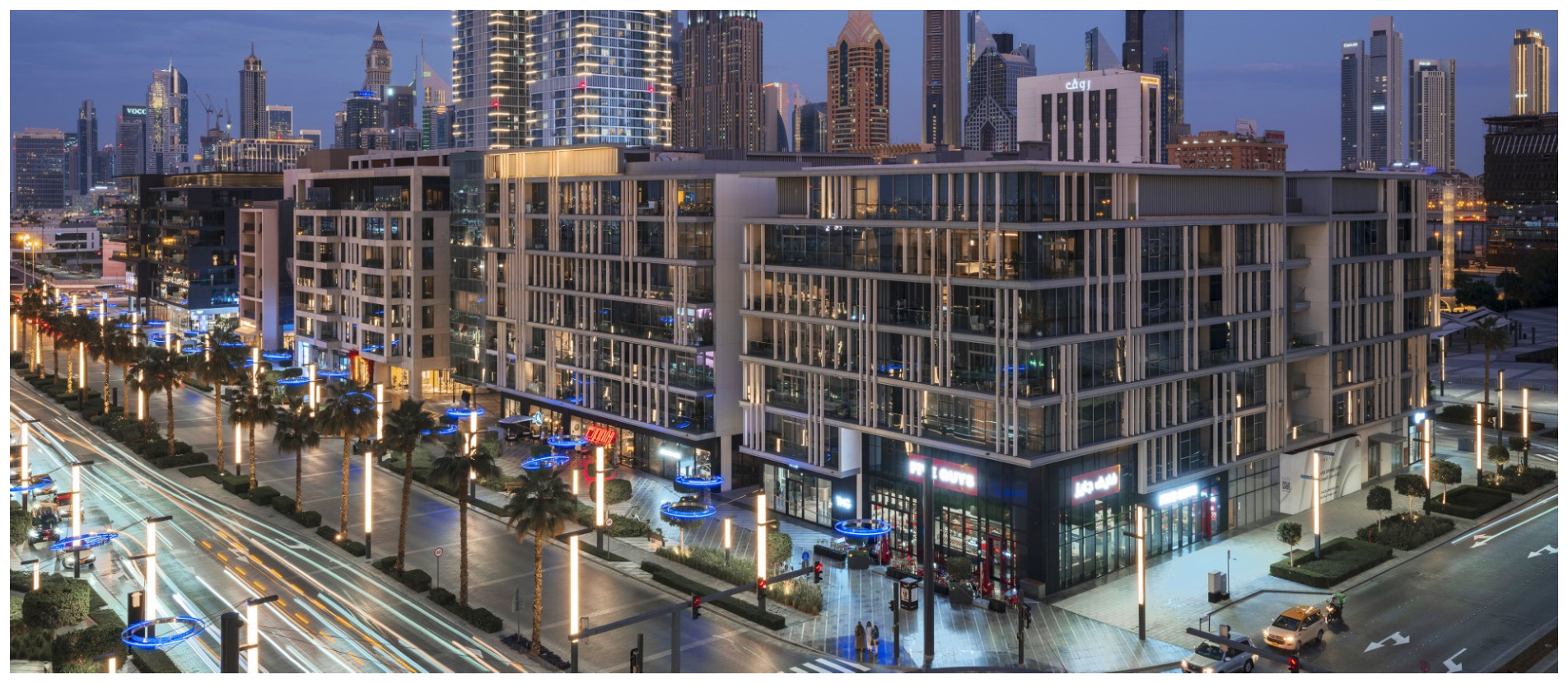

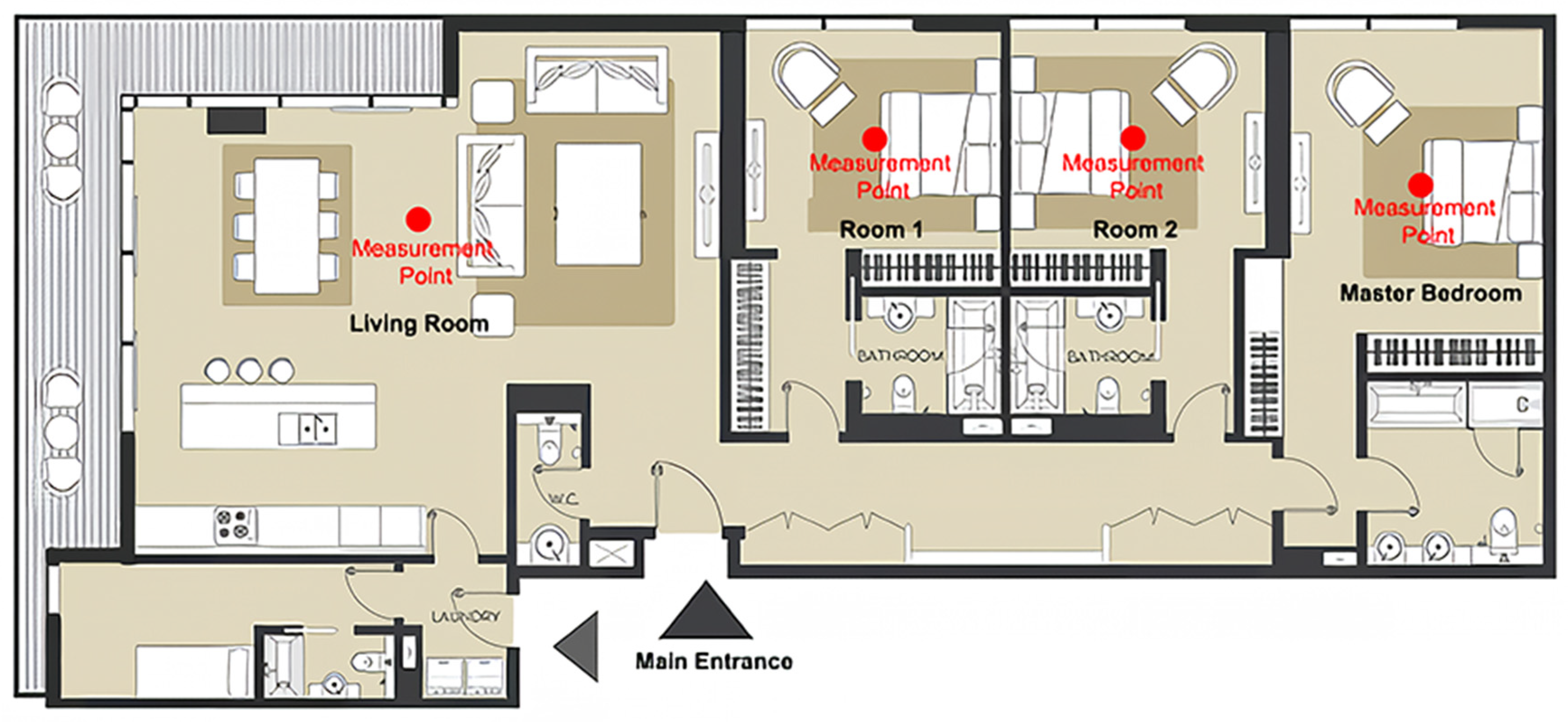
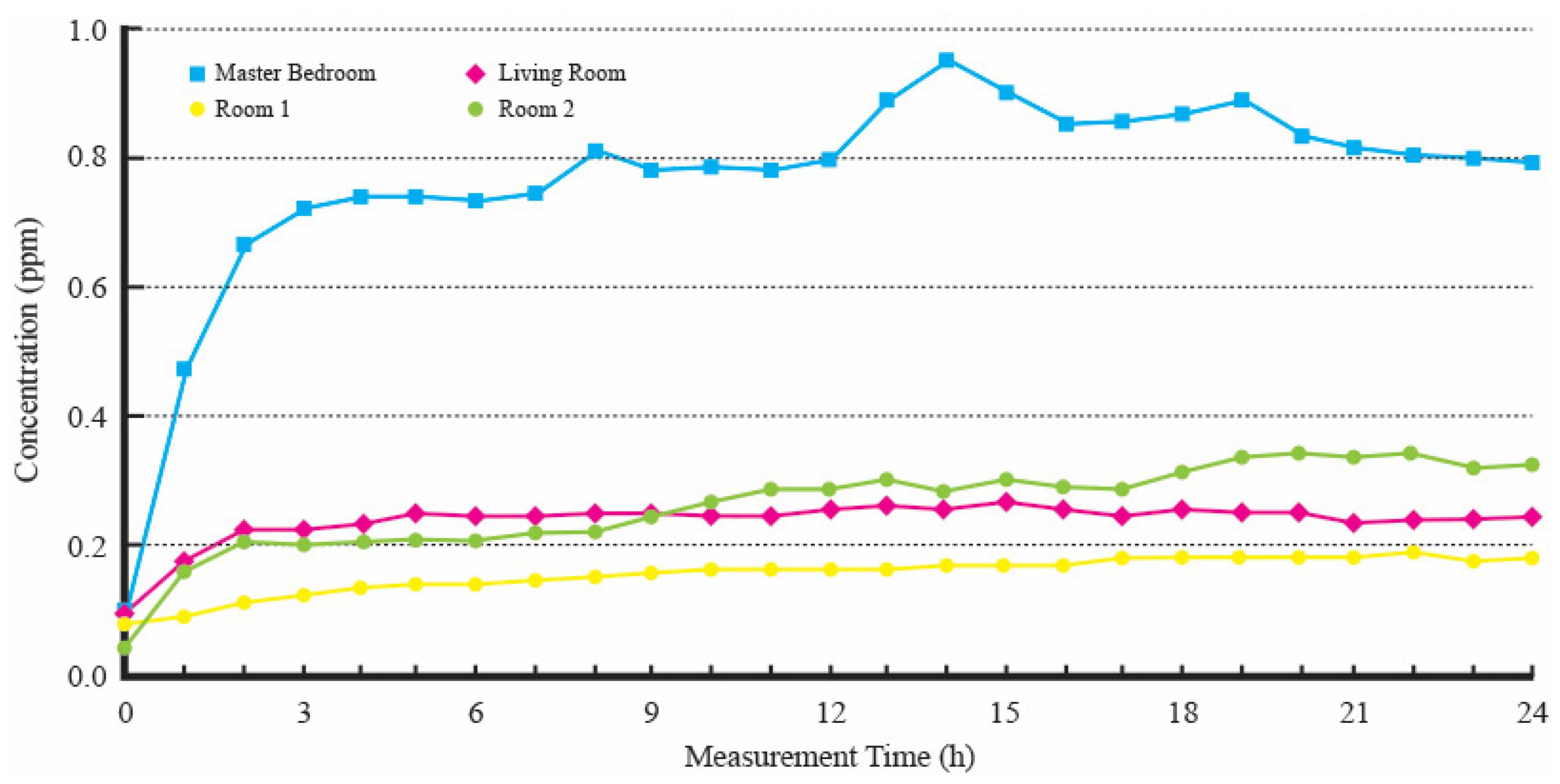
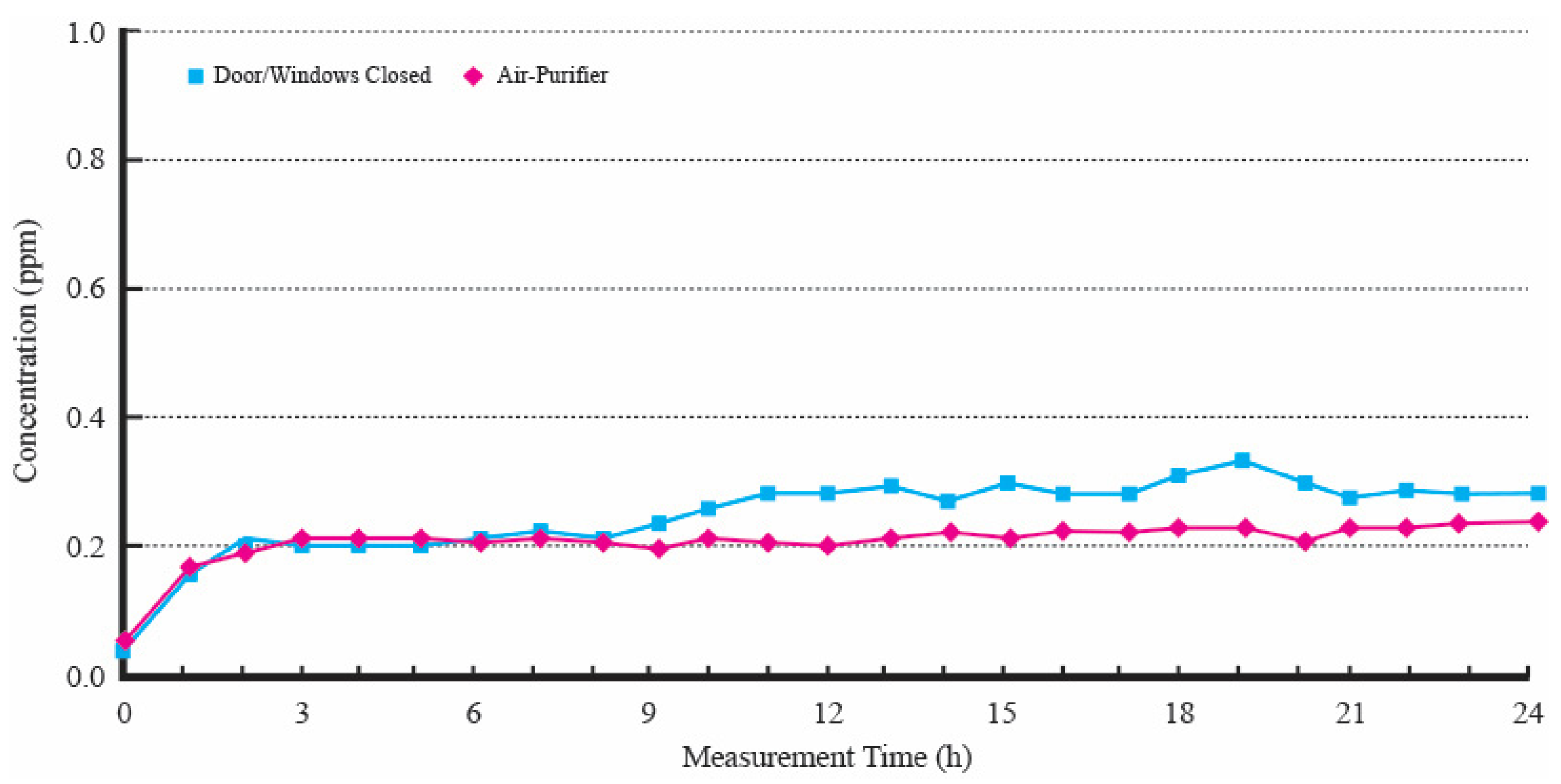
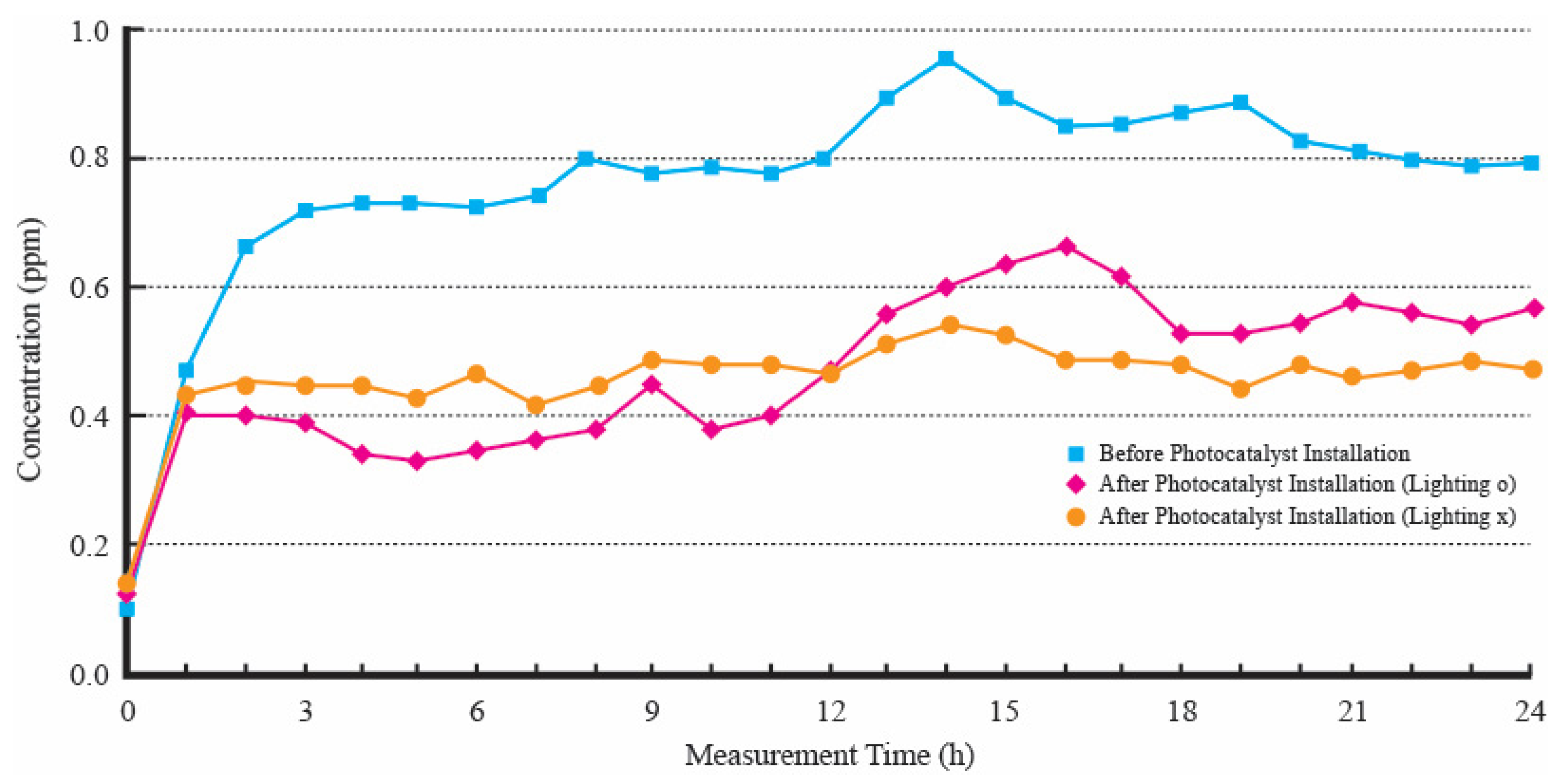
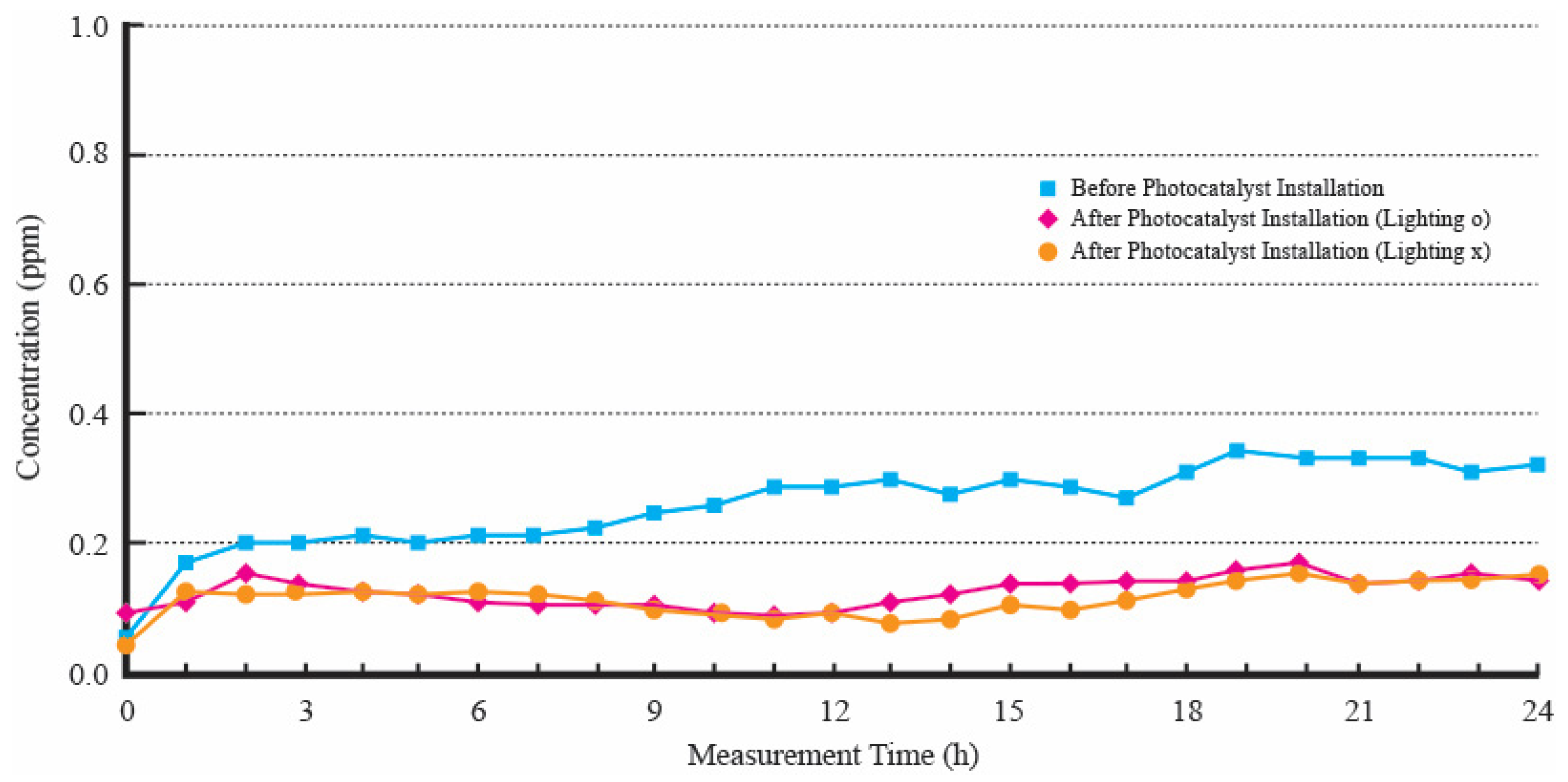
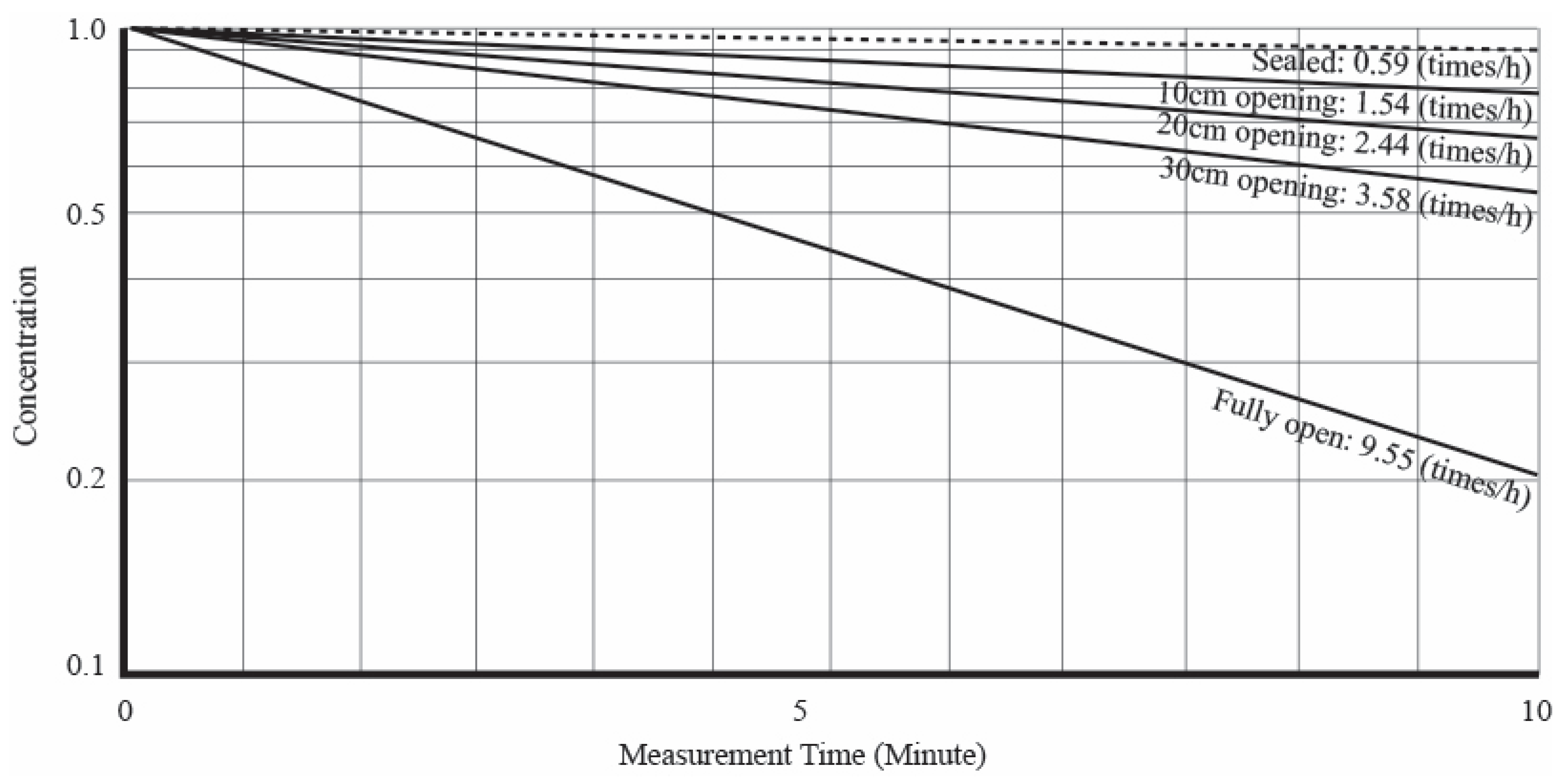
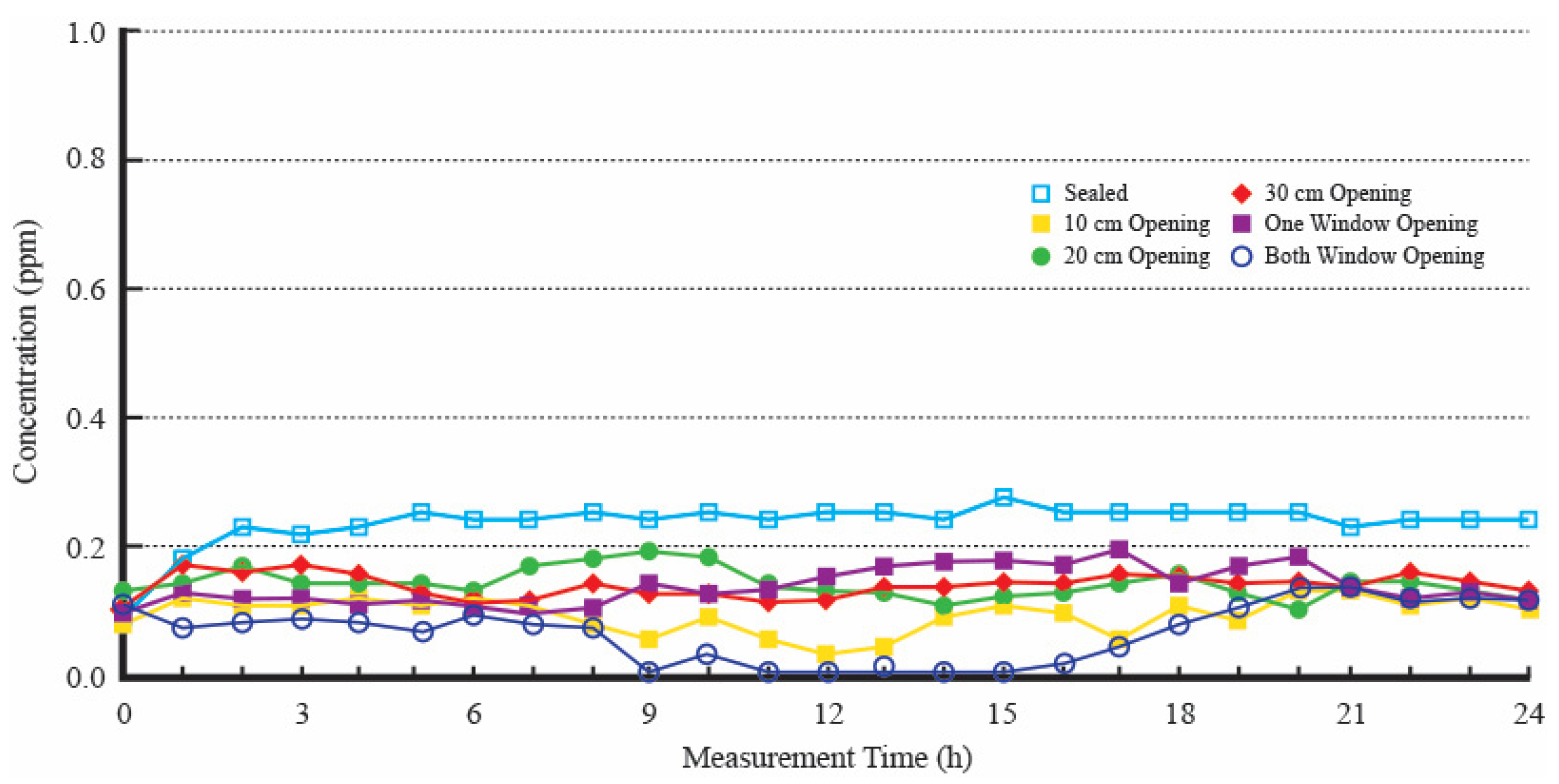

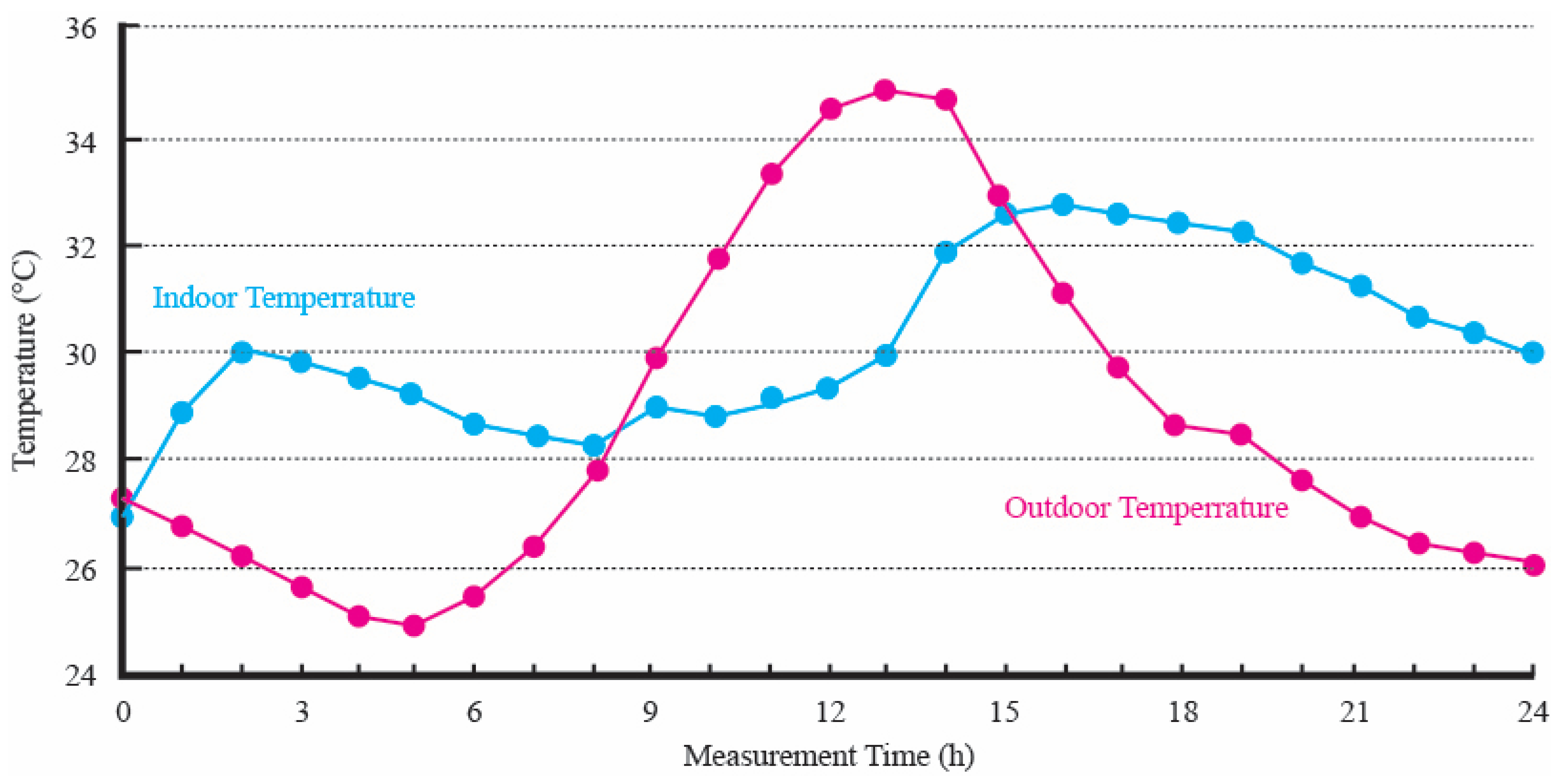
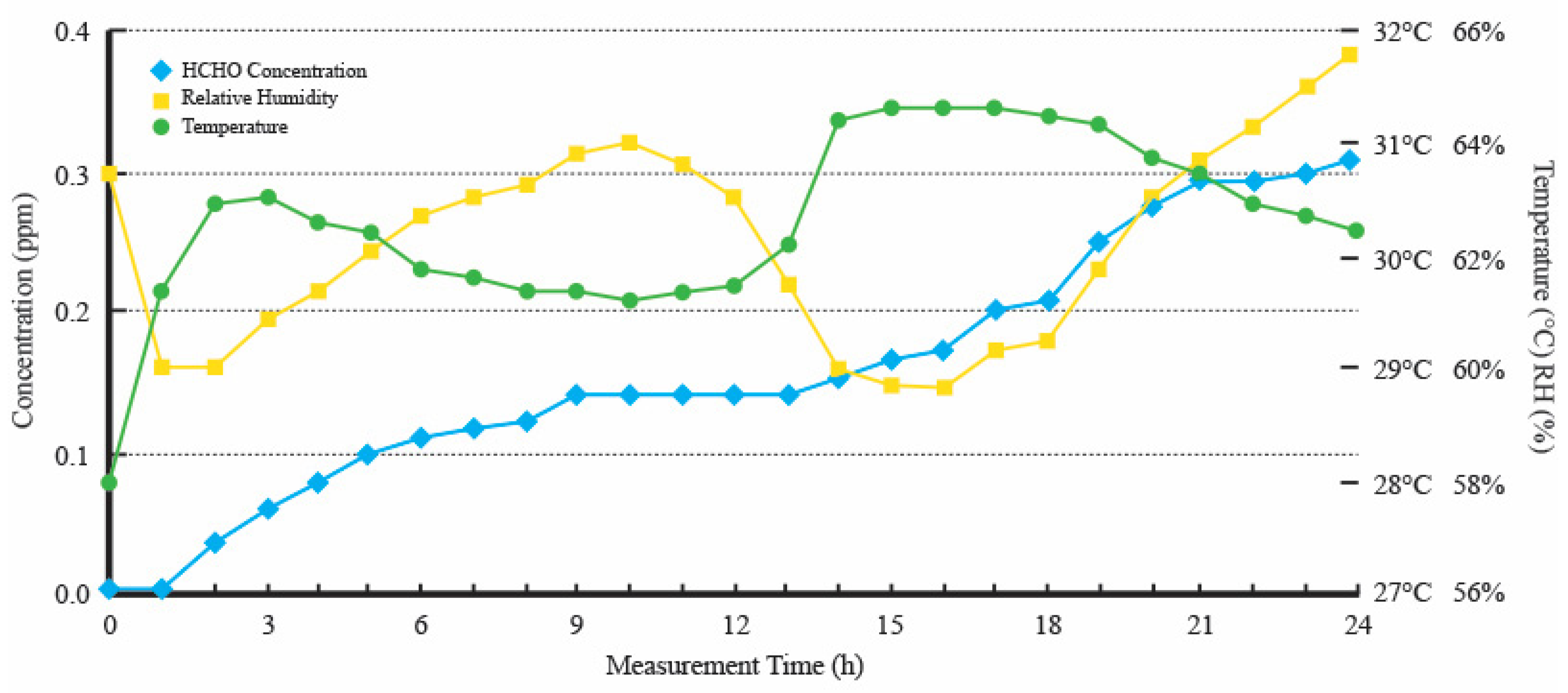
| Hazardous Substances | United States | Europe (WHO) | Japan | South Korea | UAE (Dubai) |
|---|---|---|---|---|---|
| Formaldehyde (HCHO) | 0.1 ppm (ASHRAE) | 100 µg/m3 (30 min) | 100 µg/m3 (JSHS) | 100 µg/m3 (MOE) | 0.08 ppm (Municipality) |
| Carbon Dioxide (CO2) | 1000 ppm (ASHRAE) | 920 ppm (24 h) | 1000 ppm (JBSA) (JSHS) | 1000 ppm (MOE) | N/A |
| Carbon Monoxide (CO) | 25 ppm (EPA) (8 h) | 10 ppm (8 h) | 10 ppm (JBSA) (JSHS) | 10–25 ppm (MOE) (MOHW) | N/A |
| Nitrogen Dioxide (NO2) | 0.053 ppm (NAAQS) | 40 µg/m3 (1 year) | N/A | 0.05–0.03 ppm (MOE) | N/A |
| Ozone (O3) | N/A | 120 µg/m3 (8 h) | N/A | 0.06–0.08 ppm (MOE) | N/A |
| Radon | 4.0 pCi/L (EPA) | 2.7 pCi/L | N/A | 4.0 pCi/L (MOE) | N/A |
| Total Suspended Particles (TSPs) | 25 µg/m3 (24 h) | 100–120 µg/m3 (8 h) | 0.1 mg/m3 (JSHS) | 150 µg/m3 (MOE) (MOHW) | 150 µg/m3 (Municipality) |
| Volatile Organic Components (VOCs) | N/A | 0.2–0.6 mg/m3 (FISIAQ) | 0.5 mg/m3 (JSHS) | 400–1000 µg/m3 (MOE) | 300 µg/m3 (Municipality) |
| Measurement Contents | Living Room | MBR | Room 1 | Room 2 |
|---|---|---|---|---|
| Area (m2) | 34.44 | 16.24 | 10.56 | 10.56 |
| Volume (m3) | 80.59 | 45.67 | 28.34 | 28.34 |
| Door area (m2) | 2.10 | 2.10 | 1.89 | 1.89 |
| Window area (m2) | 9.54 | 3.84 | 5.94 | 6.60 |
| Window area/Actual volume | 0.118 | 0.084 | 0.21 | 0.23 |
| Window at Balcony area (m2) | 6.6 | 5.54 | 4.4 | 3.66 |
| Window at Balcony area/Actual volume | 0.082 | 0.121 | 0.155 | 0.129 |
| Indoor window area/Actual volume | 0.118 | 0.084 | 0.21 | 0.23 |
| Area when opened by 10 cm (m2) | 0.22 | 0.16 | 0.22 | 0.22 |
| Area when opened by 20 cm (m2) | 0.44 | 0.32 | 0.44 | 0.44 |
| Area when opened by 30 cm (m2) | 0.66 | 0.48 | 0.66 | 0.66 |
| Area when fully open (m2) | 1.98 | 1.92 | 1.98 | 1.98 |
| Equipment Name | Model Name |
|---|---|
| Formaldehyde Meter | Formaldemeter 400, Measurement range: 0~50 ppm, Accuracy: 2 ppm ± 10%, Recording: AMS-2 |
| Temperature and Humidity Meter | Testo 451 Digital Temperature and Humidity |
| Temperature Measurement | Yokogawa LR 8100E, T type Thermocouple |
| Air Purifier | Air volume: 5.3 m3/min, Dust collection rate: 99.5%, Rated gas removal capacity: 3200 mL, Power consumption: 65 W Removable Gases: NH3, VOCs, SO2, etc. |
| Photocatalyst | Titanium dioxide (TIO2), Milky liquid type |
Disclaimer/Publisher’s Note: The statements, opinions and data contained in all publications are solely those of the individual author(s) and contributor(s) and not of MDPI and/or the editor(s). MDPI and/or the editor(s) disclaim responsibility for any injury to people or property resulting from any ideas, methods, instructions or products referred to in the content. |
© 2024 by the authors. Licensee MDPI, Basel, Switzerland. This article is an open access article distributed under the terms and conditions of the Creative Commons Attribution (CC BY) license (https://creativecommons.org/licenses/by/4.0/).
Share and Cite
Jung, C.; Alshamasi, S.M. Indoor Air Quality Management in Dubai: Assessing the Efficacy of Air Purifiers, Photocatalysts, and Window Ventilation in Reducing HCHO. Buildings 2024, 14, 2815. https://doi.org/10.3390/buildings14092815
Jung C, Alshamasi SM. Indoor Air Quality Management in Dubai: Assessing the Efficacy of Air Purifiers, Photocatalysts, and Window Ventilation in Reducing HCHO. Buildings. 2024; 14(9):2815. https://doi.org/10.3390/buildings14092815
Chicago/Turabian StyleJung, Chuloh, and Shams Mohammed Alshamasi. 2024. "Indoor Air Quality Management in Dubai: Assessing the Efficacy of Air Purifiers, Photocatalysts, and Window Ventilation in Reducing HCHO" Buildings 14, no. 9: 2815. https://doi.org/10.3390/buildings14092815







